EMI Shielding Products
- Custom Gasket Fabrication
- Connector Gaskets
- Bonded O Ring
- Custom Gaskets
- Conduct-O-Knit Knitted Wire Mesh
- Conduct-O-Seal Combo Gasket
- Conduct-O-Elastomer
- Conduct-O-Seal Oriented Wire in Silicone Gasket Material
- Conduct-O-Mesh Tape
- Conduct-O-Foam
- Conduct-O-Bond
- Optical Filters For Electronic Displays
- Shielded Vent Panels
- ESC Board Level Shielding
- 300 Series
Three Common EMI Shielding Materials
To get the most from your EMI shields, you need to use the best material for your specific application. Not all materials provide the same levels of shielding and performance. Below, we want to highlight three common types of metal. To solve unique problems, engineers sometimes use a combination of materials.
 Three popular EMI shielding materials include:
Three popular EMI shielding materials include:
Nickel Silver / Copper Alloy 770 – This material is often referred to as alloy 770. The alloy contains varying amounts of zinc, copper, and nickel. This material is ideal for use in environments where corrosion is a problem. The material is also great when working in mid kHz ranges that go to GHz. Alloy 770 has a permeability of 1, so the material is used to build MRI machines.
Copper – Alloy 770 and copper are not the same. Copper is often considered the most reliable of all EMI shielding materials because it reduces electrical and magnetic waves. It is not easy to find a piece of electronic hospital equipment that does not have some copper EMI shielding. Copper does cost more than other materials and pre-tin-plated steel, but it is the most conductive of all EMI shielding materials.
Aluminum – This material works well because it boasts a high strength-to-weight ratio while remaining highly conductive. It is important to keep in mind that aluminum is prone to corrosion, and it has oxidation properties. Oxidation compromises the structural integrity of the metal.
EMI RFI Shielding
- EMI & RFI Protection for Medical Devices and EquipmentKeeping medical equipment safe should be your top priority. EMI shielding and RFI shielding play a critical role in making that happen.
- EMI and RFI in Everyday Life
- Creating Fast & Small Electronics with RFI Shielding



